Business Management Project: Research Methodologies and Marketing
VerifiedAdded on 2023/01/19
|9
|2693
|61
Report
AI Summary
This report presents a comprehensive analysis of business management, employing both quantitative and qualitative research methodologies. The study focuses on marketing, human capital management and explores the impact of human resource management on profit margins. It includes an in-depth examination of research philosophies, approaches, strategies, and data analysis techniques. The report provides findings, recommendations, and a critical literature review, offering insights into effective human resource management practices and their implications for organizational success. The report highlights the importance of both internal and external factors in data collection and analysis, emphasizing the need for structured interviews and questionnaires to gather comprehensive information. The overall goal is to enhance learning and provide a disciplined approach to understanding the role of human resource management in various business scenarios.
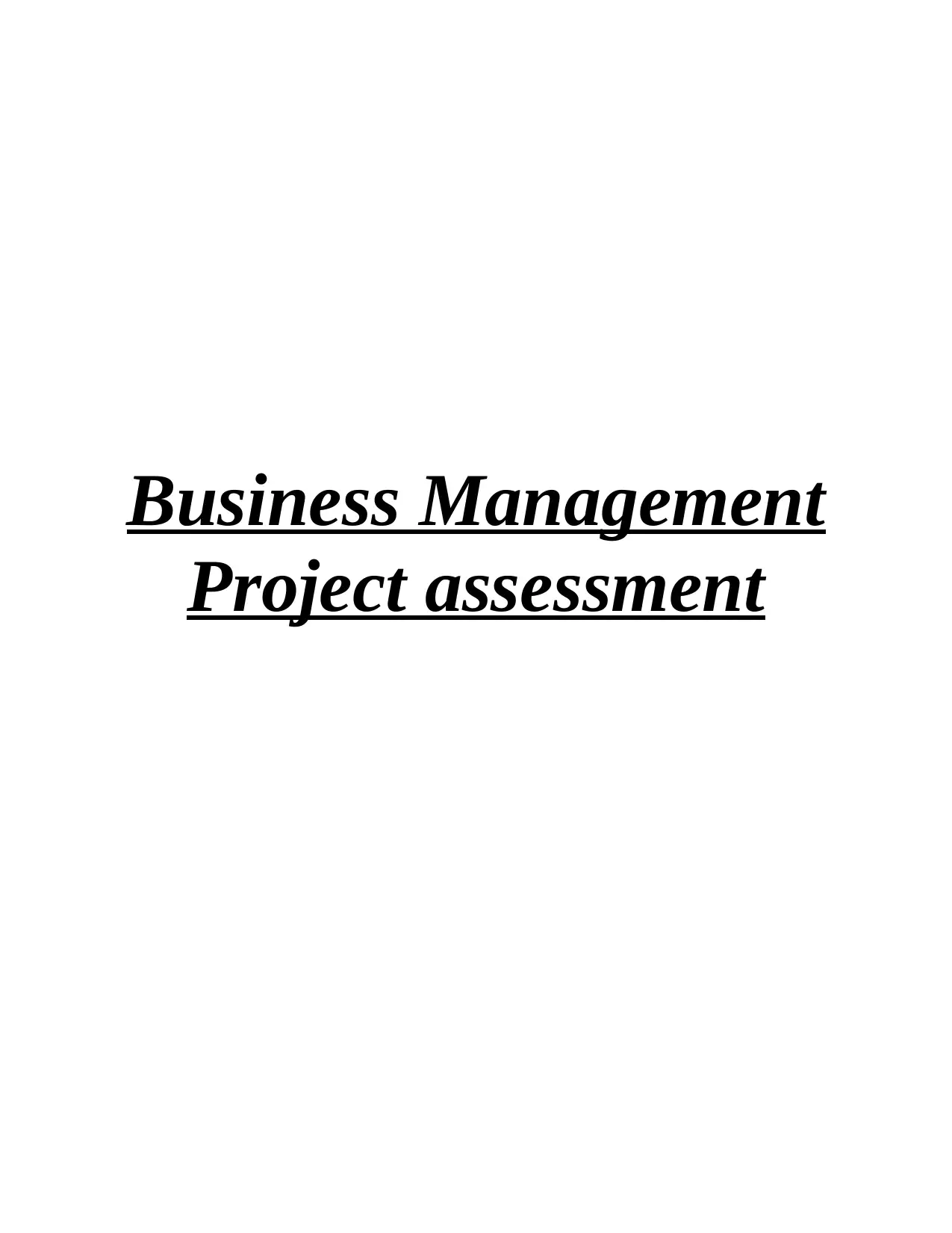
Business Management
Project assessment
Project assessment
Paraphrase This Document
Need a fresh take? Get an instant paraphrase of this document with our AI Paraphraser
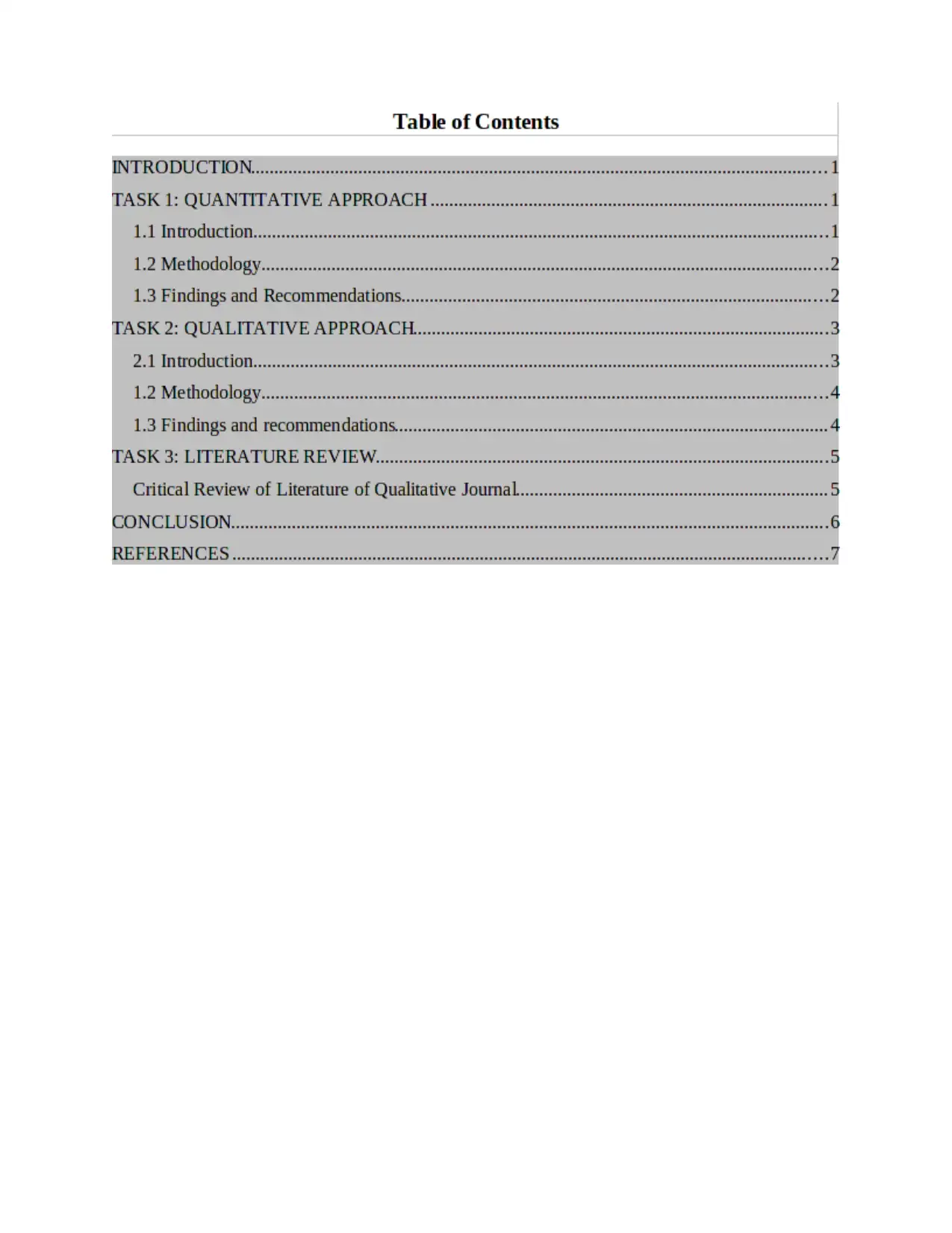
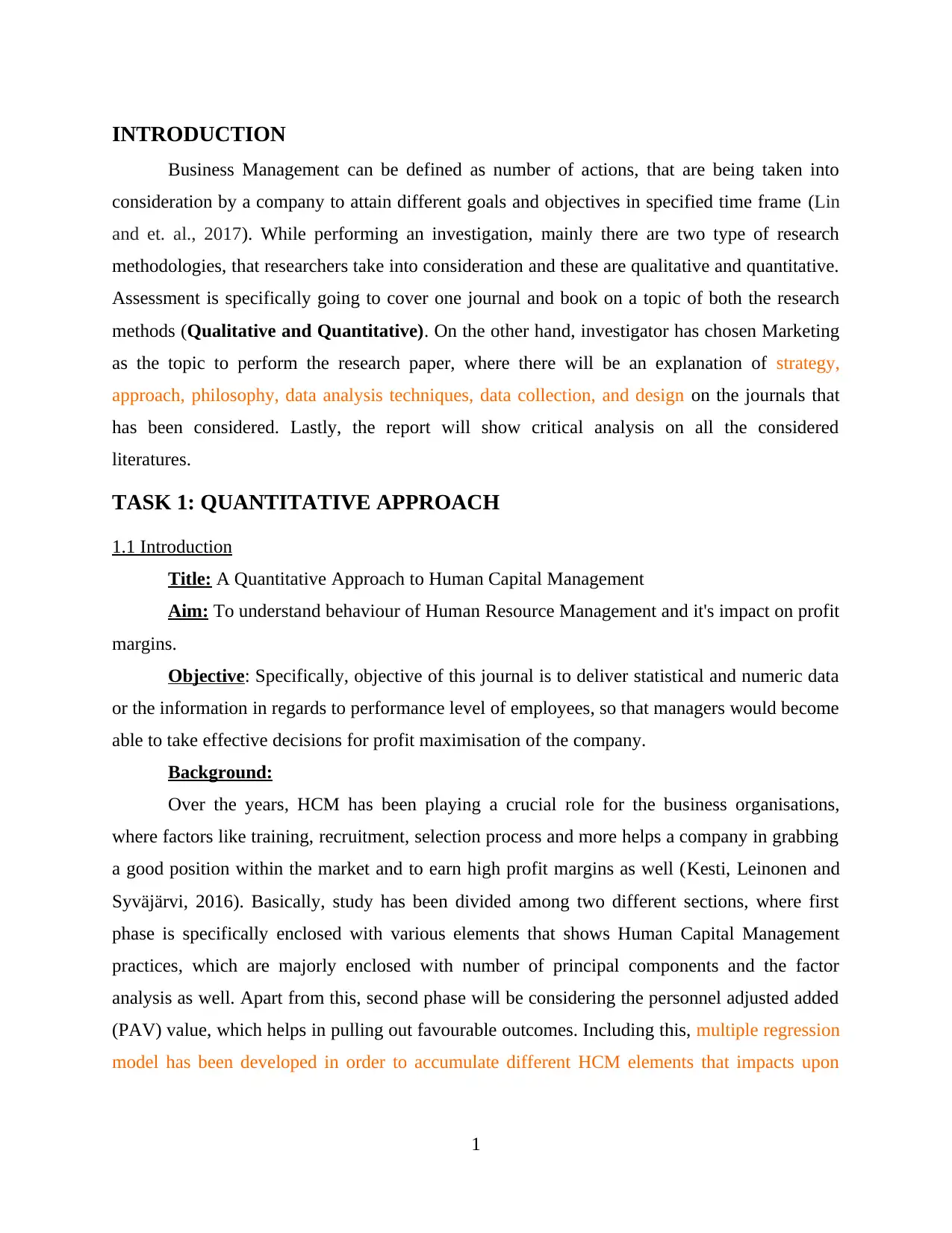
INTRODUCTION
Business Management can be defined as number of actions, that are being taken into
consideration by a company to attain different goals and objectives in specified time frame (Lin
and et. al., 2017). While performing an investigation, mainly there are two type of research
methodologies, that researchers take into consideration and these are qualitative and quantitative.
Assessment is specifically going to cover one journal and book on a topic of both the research
methods (Qualitative and Quantitative). On the other hand, investigator has chosen Marketing
as the topic to perform the research paper, where there will be an explanation of strategy,
approach, philosophy, data analysis techniques, data collection, and design on the journals that
has been considered. Lastly, the report will show critical analysis on all the considered
literatures.
TASK 1: QUANTITATIVE APPROACH
1.1 Introduction
Title: A Quantitative Approach to Human Capital Management
Aim: To understand behaviour of Human Resource Management and it's impact on profit
margins.
Objective: Specifically, objective of this journal is to deliver statistical and numeric data
or the information in regards to performance level of employees, so that managers would become
able to take effective decisions for profit maximisation of the company.
Background:
Over the years, HCM has been playing a crucial role for the business organisations,
where factors like training, recruitment, selection process and more helps a company in grabbing
a good position within the market and to earn high profit margins as well (Kesti, Leinonen and
Syväjärvi, 2016). Basically, study has been divided among two different sections, where first
phase is specifically enclosed with various elements that shows Human Capital Management
practices, which are majorly enclosed with number of principal components and the factor
analysis as well. Apart from this, second phase will be considering the personnel adjusted added
(PAV) value, which helps in pulling out favourable outcomes. Including this, multiple regression
model has been developed in order to accumulate different HCM elements that impacts upon
1
Business Management can be defined as number of actions, that are being taken into
consideration by a company to attain different goals and objectives in specified time frame (Lin
and et. al., 2017). While performing an investigation, mainly there are two type of research
methodologies, that researchers take into consideration and these are qualitative and quantitative.
Assessment is specifically going to cover one journal and book on a topic of both the research
methods (Qualitative and Quantitative). On the other hand, investigator has chosen Marketing
as the topic to perform the research paper, where there will be an explanation of strategy,
approach, philosophy, data analysis techniques, data collection, and design on the journals that
has been considered. Lastly, the report will show critical analysis on all the considered
literatures.
TASK 1: QUANTITATIVE APPROACH
1.1 Introduction
Title: A Quantitative Approach to Human Capital Management
Aim: To understand behaviour of Human Resource Management and it's impact on profit
margins.
Objective: Specifically, objective of this journal is to deliver statistical and numeric data
or the information in regards to performance level of employees, so that managers would become
able to take effective decisions for profit maximisation of the company.
Background:
Over the years, HCM has been playing a crucial role for the business organisations,
where factors like training, recruitment, selection process and more helps a company in grabbing
a good position within the market and to earn high profit margins as well (Kesti, Leinonen and
Syväjärvi, 2016). Basically, study has been divided among two different sections, where first
phase is specifically enclosed with various elements that shows Human Capital Management
practices, which are majorly enclosed with number of principal components and the factor
analysis as well. Apart from this, second phase will be considering the personnel adjusted added
(PAV) value, which helps in pulling out favourable outcomes. Including this, multiple regression
model has been developed in order to accumulate different HCM elements that impacts upon
1
⊘ This is a preview!⊘
Do you want full access?
Subscribe today to unlock all pages.

Trusted by 1+ million students worldwide
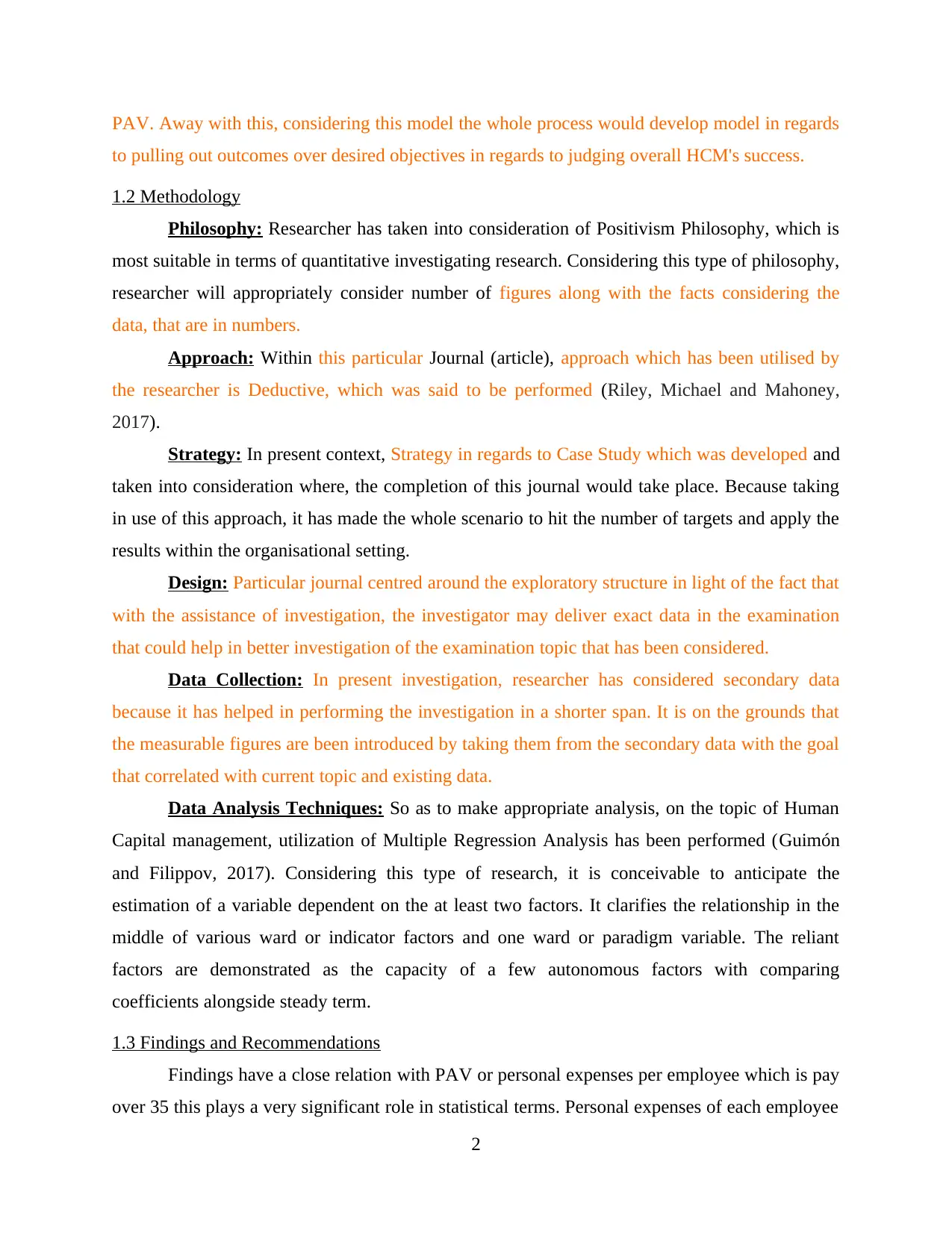
PAV. Away with this, considering this model the whole process would develop model in regards
to pulling out outcomes over desired objectives in regards to judging overall HCM's success.
1.2 Methodology
Philosophy: Researcher has taken into consideration of Positivism Philosophy, which is
most suitable in terms of quantitative investigating research. Considering this type of philosophy,
researcher will appropriately consider number of figures along with the facts considering the
data, that are in numbers.
Approach: Within this particular Journal (article), approach which has been utilised by
the researcher is Deductive, which was said to be performed (Riley, Michael and Mahoney,
2017).
Strategy: In present context, Strategy in regards to Case Study which was developed and
taken into consideration where, the completion of this journal would take place. Because taking
in use of this approach, it has made the whole scenario to hit the number of targets and apply the
results within the organisational setting.
Design: Particular journal centred around the exploratory structure in light of the fact that
with the assistance of investigation, the investigator may deliver exact data in the examination
that could help in better investigation of the examination topic that has been considered.
Data Collection: In present investigation, researcher has considered secondary data
because it has helped in performing the investigation in a shorter span. It is on the grounds that
the measurable figures are been introduced by taking them from the secondary data with the goal
that correlated with current topic and existing data.
Data Analysis Techniques: So as to make appropriate analysis, on the topic of Human
Capital management, utilization of Multiple Regression Analysis has been performed (Guimón
and Filippov, 2017). Considering this type of research, it is conceivable to anticipate the
estimation of a variable dependent on the at least two factors. It clarifies the relationship in the
middle of various ward or indicator factors and one ward or paradigm variable. The reliant
factors are demonstrated as the capacity of a few autonomous factors with comparing
coefficients alongside steady term.
1.3 Findings and Recommendations
Findings have a close relation with PAV or personal expenses per employee which is pay
over 35 this plays a very significant role in statistical terms. Personal expenses of each employee
2
to pulling out outcomes over desired objectives in regards to judging overall HCM's success.
1.2 Methodology
Philosophy: Researcher has taken into consideration of Positivism Philosophy, which is
most suitable in terms of quantitative investigating research. Considering this type of philosophy,
researcher will appropriately consider number of figures along with the facts considering the
data, that are in numbers.
Approach: Within this particular Journal (article), approach which has been utilised by
the researcher is Deductive, which was said to be performed (Riley, Michael and Mahoney,
2017).
Strategy: In present context, Strategy in regards to Case Study which was developed and
taken into consideration where, the completion of this journal would take place. Because taking
in use of this approach, it has made the whole scenario to hit the number of targets and apply the
results within the organisational setting.
Design: Particular journal centred around the exploratory structure in light of the fact that
with the assistance of investigation, the investigator may deliver exact data in the examination
that could help in better investigation of the examination topic that has been considered.
Data Collection: In present investigation, researcher has considered secondary data
because it has helped in performing the investigation in a shorter span. It is on the grounds that
the measurable figures are been introduced by taking them from the secondary data with the goal
that correlated with current topic and existing data.
Data Analysis Techniques: So as to make appropriate analysis, on the topic of Human
Capital management, utilization of Multiple Regression Analysis has been performed (Guimón
and Filippov, 2017). Considering this type of research, it is conceivable to anticipate the
estimation of a variable dependent on the at least two factors. It clarifies the relationship in the
middle of various ward or indicator factors and one ward or paradigm variable. The reliant
factors are demonstrated as the capacity of a few autonomous factors with comparing
coefficients alongside steady term.
1.3 Findings and Recommendations
Findings have a close relation with PAV or personal expenses per employee which is pay
over 35 this plays a very significant role in statistical terms. Personal expenses of each employee
2
Paraphrase This Document
Need a fresh take? Get an instant paraphrase of this document with our AI Paraphraser
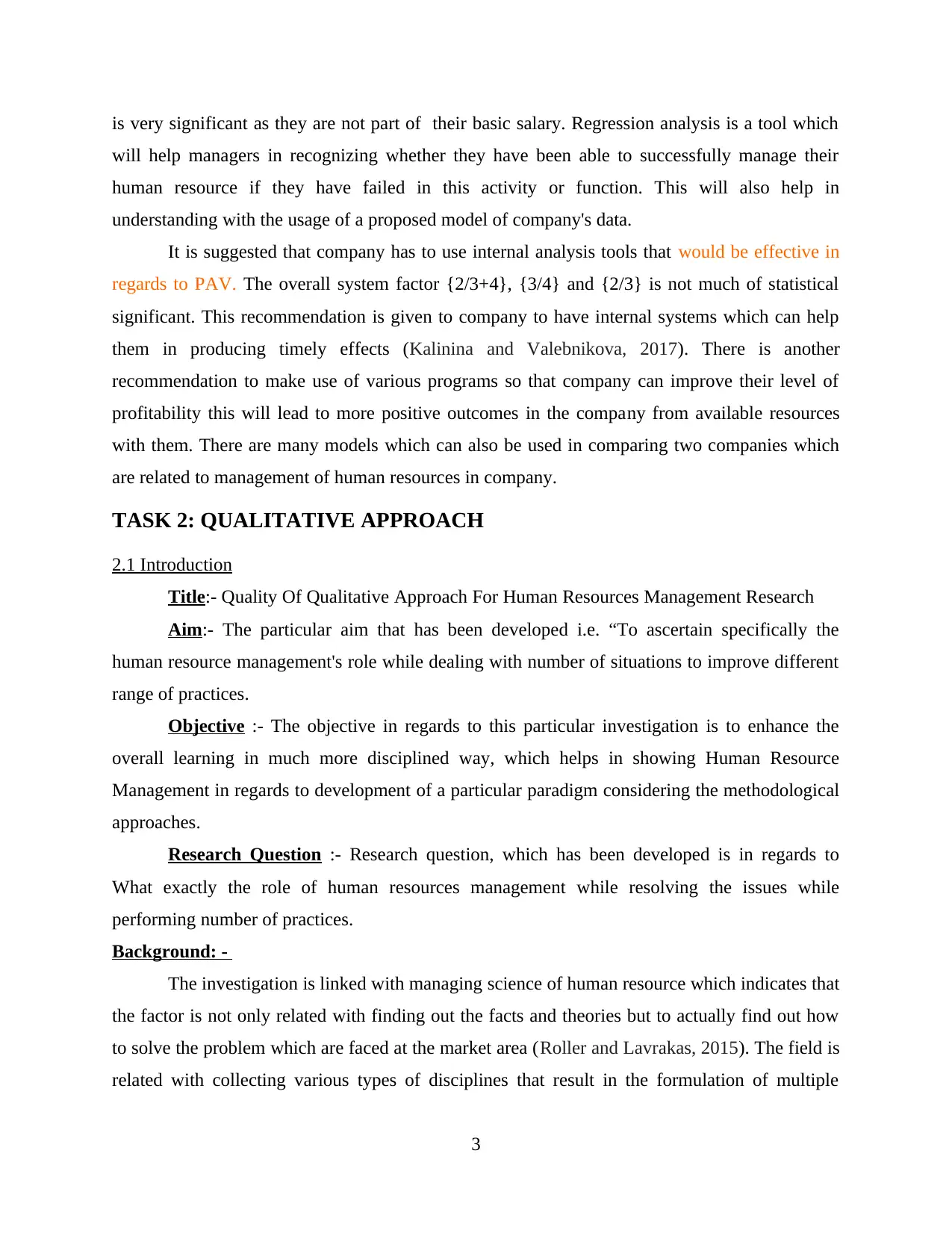
is very significant as they are not part of their basic salary. Regression analysis is a tool which
will help managers in recognizing whether they have been able to successfully manage their
human resource if they have failed in this activity or function. This will also help in
understanding with the usage of a proposed model of company's data.
It is suggested that company has to use internal analysis tools that would be effective in
regards to PAV. The overall system factor {2/3+4}, {3/4} and {2/3} is not much of statistical
significant. This recommendation is given to company to have internal systems which can help
them in producing timely effects (Kalinina and Valebnikova, 2017). There is another
recommendation to make use of various programs so that company can improve their level of
profitability this will lead to more positive outcomes in the company from available resources
with them. There are many models which can also be used in comparing two companies which
are related to management of human resources in company.
TASK 2: QUALITATIVE APPROACH
2.1 Introduction
Title:- Quality Of Qualitative Approach For Human Resources Management Research
Aim:- The particular aim that has been developed i.e. “To ascertain specifically the
human resource management's role while dealing with number of situations to improve different
range of practices.
Objective :- The objective in regards to this particular investigation is to enhance the
overall learning in much more disciplined way, which helps in showing Human Resource
Management in regards to development of a particular paradigm considering the methodological
approaches.
Research Question :- Research question, which has been developed is in regards to
What exactly the role of human resources management while resolving the issues while
performing number of practices.
Background: -
The investigation is linked with managing science of human resource which indicates that
the factor is not only related with finding out the facts and theories but to actually find out how
to solve the problem which are faced at the market area (Roller and Lavrakas, 2015). The field is
related with collecting various types of disciplines that result in the formulation of multiple
3
will help managers in recognizing whether they have been able to successfully manage their
human resource if they have failed in this activity or function. This will also help in
understanding with the usage of a proposed model of company's data.
It is suggested that company has to use internal analysis tools that would be effective in
regards to PAV. The overall system factor {2/3+4}, {3/4} and {2/3} is not much of statistical
significant. This recommendation is given to company to have internal systems which can help
them in producing timely effects (Kalinina and Valebnikova, 2017). There is another
recommendation to make use of various programs so that company can improve their level of
profitability this will lead to more positive outcomes in the company from available resources
with them. There are many models which can also be used in comparing two companies which
are related to management of human resources in company.
TASK 2: QUALITATIVE APPROACH
2.1 Introduction
Title:- Quality Of Qualitative Approach For Human Resources Management Research
Aim:- The particular aim that has been developed i.e. “To ascertain specifically the
human resource management's role while dealing with number of situations to improve different
range of practices.
Objective :- The objective in regards to this particular investigation is to enhance the
overall learning in much more disciplined way, which helps in showing Human Resource
Management in regards to development of a particular paradigm considering the methodological
approaches.
Research Question :- Research question, which has been developed is in regards to
What exactly the role of human resources management while resolving the issues while
performing number of practices.
Background: -
The investigation is linked with managing science of human resource which indicates that
the factor is not only related with finding out the facts and theories but to actually find out how
to solve the problem which are faced at the market area (Roller and Lavrakas, 2015). The field is
related with collecting various types of disciplines that result in the formulation of multiple
3
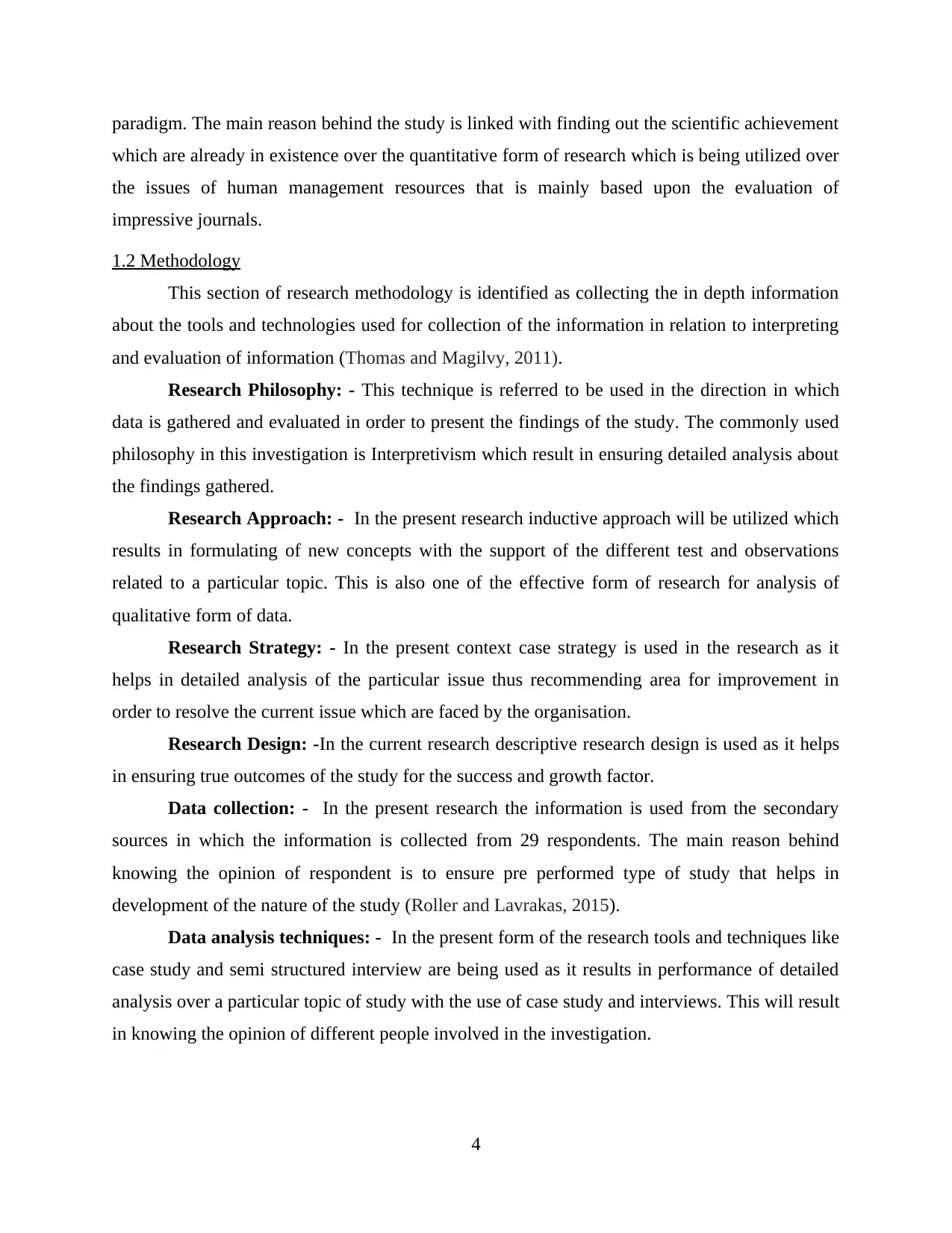
paradigm. The main reason behind the study is linked with finding out the scientific achievement
which are already in existence over the quantitative form of research which is being utilized over
the issues of human management resources that is mainly based upon the evaluation of
impressive journals.
1.2 Methodology
This section of research methodology is identified as collecting the in depth information
about the tools and technologies used for collection of the information in relation to interpreting
and evaluation of information (Thomas and Magilvy, 2011).
Research Philosophy: - This technique is referred to be used in the direction in which
data is gathered and evaluated in order to present the findings of the study. The commonly used
philosophy in this investigation is Interpretivism which result in ensuring detailed analysis about
the findings gathered.
Research Approach: - In the present research inductive approach will be utilized which
results in formulating of new concepts with the support of the different test and observations
related to a particular topic. This is also one of the effective form of research for analysis of
qualitative form of data.
Research Strategy: - In the present context case strategy is used in the research as it
helps in detailed analysis of the particular issue thus recommending area for improvement in
order to resolve the current issue which are faced by the organisation.
Research Design: -In the current research descriptive research design is used as it helps
in ensuring true outcomes of the study for the success and growth factor.
Data collection: - In the present research the information is used from the secondary
sources in which the information is collected from 29 respondents. The main reason behind
knowing the opinion of respondent is to ensure pre performed type of study that helps in
development of the nature of the study (Roller and Lavrakas, 2015).
Data analysis techniques: - In the present form of the research tools and techniques like
case study and semi structured interview are being used as it results in performance of detailed
analysis over a particular topic of study with the use of case study and interviews. This will result
in knowing the opinion of different people involved in the investigation.
4
which are already in existence over the quantitative form of research which is being utilized over
the issues of human management resources that is mainly based upon the evaluation of
impressive journals.
1.2 Methodology
This section of research methodology is identified as collecting the in depth information
about the tools and technologies used for collection of the information in relation to interpreting
and evaluation of information (Thomas and Magilvy, 2011).
Research Philosophy: - This technique is referred to be used in the direction in which
data is gathered and evaluated in order to present the findings of the study. The commonly used
philosophy in this investigation is Interpretivism which result in ensuring detailed analysis about
the findings gathered.
Research Approach: - In the present research inductive approach will be utilized which
results in formulating of new concepts with the support of the different test and observations
related to a particular topic. This is also one of the effective form of research for analysis of
qualitative form of data.
Research Strategy: - In the present context case strategy is used in the research as it
helps in detailed analysis of the particular issue thus recommending area for improvement in
order to resolve the current issue which are faced by the organisation.
Research Design: -In the current research descriptive research design is used as it helps
in ensuring true outcomes of the study for the success and growth factor.
Data collection: - In the present research the information is used from the secondary
sources in which the information is collected from 29 respondents. The main reason behind
knowing the opinion of respondent is to ensure pre performed type of study that helps in
development of the nature of the study (Roller and Lavrakas, 2015).
Data analysis techniques: - In the present form of the research tools and techniques like
case study and semi structured interview are being used as it results in performance of detailed
analysis over a particular topic of study with the use of case study and interviews. This will result
in knowing the opinion of different people involved in the investigation.
4
⊘ This is a preview!⊘
Do you want full access?
Subscribe today to unlock all pages.

Trusted by 1+ million students worldwide
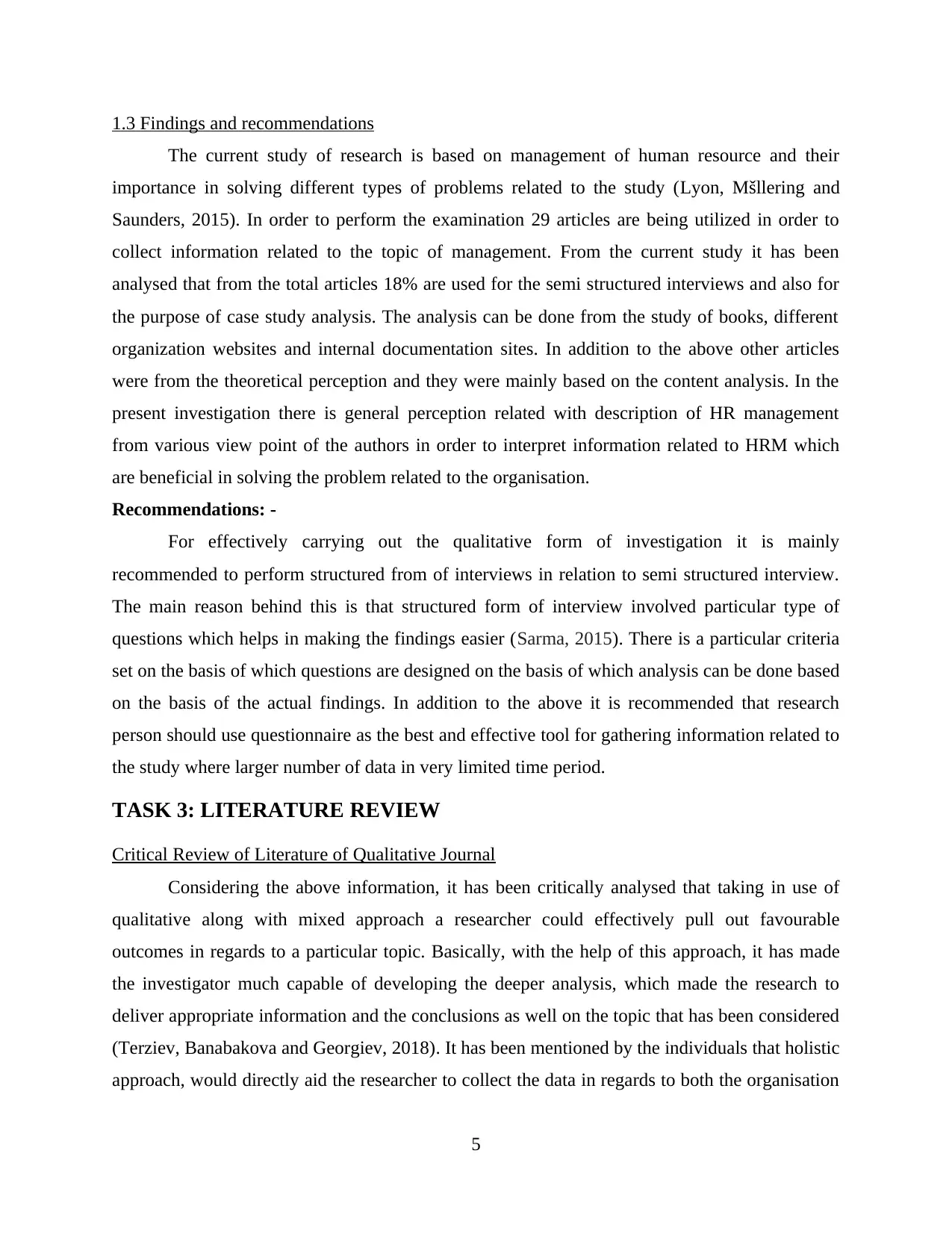
1.3 Findings and recommendations
The current study of research is based on management of human resource and their
importance in solving different types of problems related to the study (Lyon, Mšllering and
Saunders, 2015). In order to perform the examination 29 articles are being utilized in order to
collect information related to the topic of management. From the current study it has been
analysed that from the total articles 18% are used for the semi structured interviews and also for
the purpose of case study analysis. The analysis can be done from the study of books, different
organization websites and internal documentation sites. In addition to the above other articles
were from the theoretical perception and they were mainly based on the content analysis. In the
present investigation there is general perception related with description of HR management
from various view point of the authors in order to interpret information related to HRM which
are beneficial in solving the problem related to the organisation.
Recommendations: -
For effectively carrying out the qualitative form of investigation it is mainly
recommended to perform structured from of interviews in relation to semi structured interview.
The main reason behind this is that structured form of interview involved particular type of
questions which helps in making the findings easier (Sarma, 2015). There is a particular criteria
set on the basis of which questions are designed on the basis of which analysis can be done based
on the basis of the actual findings. In addition to the above it is recommended that research
person should use questionnaire as the best and effective tool for gathering information related to
the study where larger number of data in very limited time period.
TASK 3: LITERATURE REVIEW
Critical Review of Literature of Qualitative Journal
Considering the above information, it has been critically analysed that taking in use of
qualitative along with mixed approach a researcher could effectively pull out favourable
outcomes in regards to a particular topic. Basically, with the help of this approach, it has made
the investigator much capable of developing the deeper analysis, which made the research to
deliver appropriate information and the conclusions as well on the topic that has been considered
(Terziev, Banabakova and Georgiev, 2018). It has been mentioned by the individuals that holistic
approach, would directly aid the researcher to collect the data in regards to both the organisation
5
The current study of research is based on management of human resource and their
importance in solving different types of problems related to the study (Lyon, Mšllering and
Saunders, 2015). In order to perform the examination 29 articles are being utilized in order to
collect information related to the topic of management. From the current study it has been
analysed that from the total articles 18% are used for the semi structured interviews and also for
the purpose of case study analysis. The analysis can be done from the study of books, different
organization websites and internal documentation sites. In addition to the above other articles
were from the theoretical perception and they were mainly based on the content analysis. In the
present investigation there is general perception related with description of HR management
from various view point of the authors in order to interpret information related to HRM which
are beneficial in solving the problem related to the organisation.
Recommendations: -
For effectively carrying out the qualitative form of investigation it is mainly
recommended to perform structured from of interviews in relation to semi structured interview.
The main reason behind this is that structured form of interview involved particular type of
questions which helps in making the findings easier (Sarma, 2015). There is a particular criteria
set on the basis of which questions are designed on the basis of which analysis can be done based
on the basis of the actual findings. In addition to the above it is recommended that research
person should use questionnaire as the best and effective tool for gathering information related to
the study where larger number of data in very limited time period.
TASK 3: LITERATURE REVIEW
Critical Review of Literature of Qualitative Journal
Considering the above information, it has been critically analysed that taking in use of
qualitative along with mixed approach a researcher could effectively pull out favourable
outcomes in regards to a particular topic. Basically, with the help of this approach, it has made
the investigator much capable of developing the deeper analysis, which made the research to
deliver appropriate information and the conclusions as well on the topic that has been considered
(Terziev, Banabakova and Georgiev, 2018). It has been mentioned by the individuals that holistic
approach, would directly aid the researcher to collect the data in regards to both the organisation
5
Paraphrase This Document
Need a fresh take? Get an instant paraphrase of this document with our AI Paraphraser
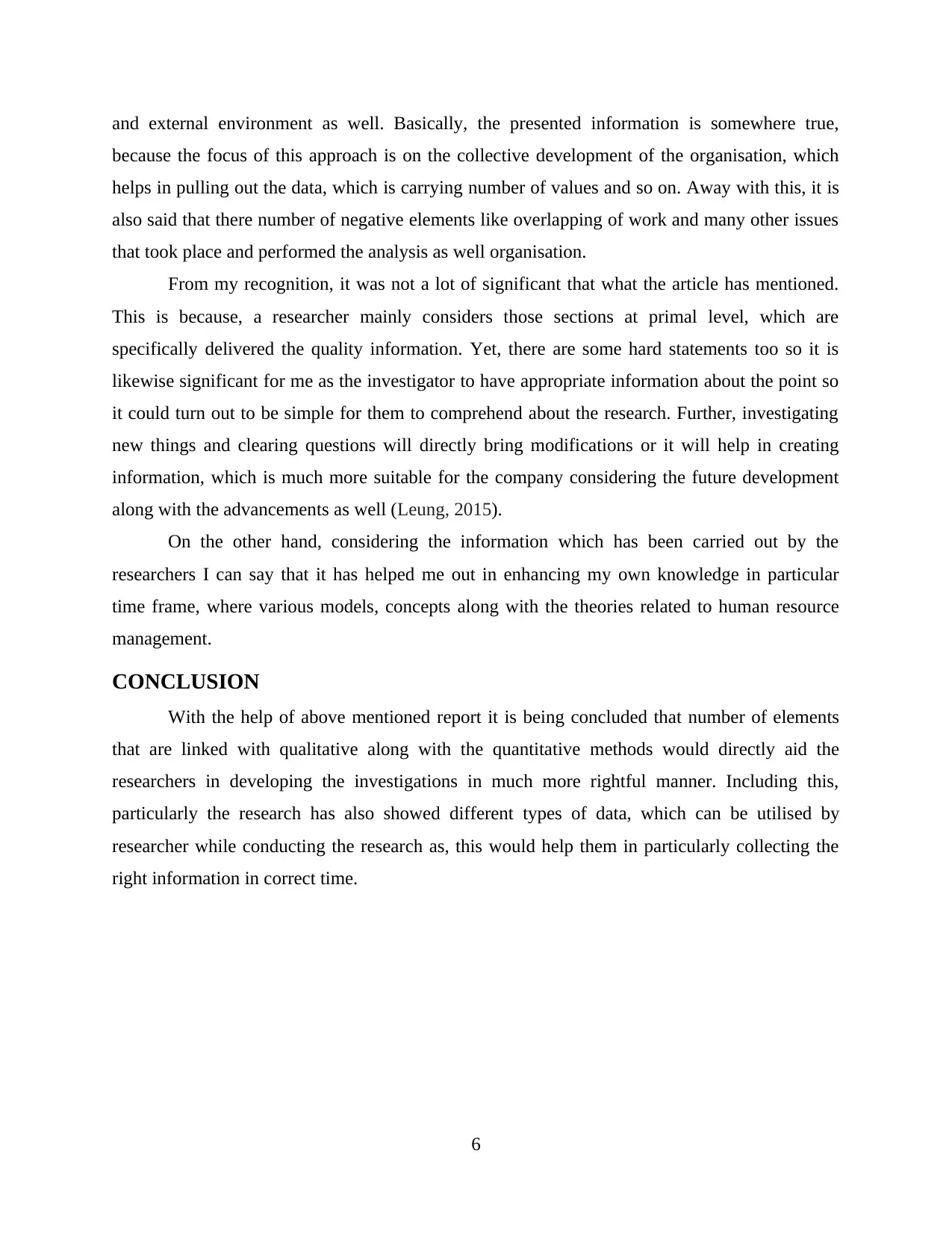
and external environment as well. Basically, the presented information is somewhere true,
because the focus of this approach is on the collective development of the organisation, which
helps in pulling out the data, which is carrying number of values and so on. Away with this, it is
also said that there number of negative elements like overlapping of work and many other issues
that took place and performed the analysis as well organisation.
From my recognition, it was not a lot of significant that what the article has mentioned.
This is because, a researcher mainly considers those sections at primal level, which are
specifically delivered the quality information. Yet, there are some hard statements too so it is
likewise significant for me as the investigator to have appropriate information about the point so
it could turn out to be simple for them to comprehend about the research. Further, investigating
new things and clearing questions will directly bring modifications or it will help in creating
information, which is much more suitable for the company considering the future development
along with the advancements as well (Leung, 2015).
On the other hand, considering the information which has been carried out by the
researchers I can say that it has helped me out in enhancing my own knowledge in particular
time frame, where various models, concepts along with the theories related to human resource
management.
CONCLUSION
With the help of above mentioned report it is being concluded that number of elements
that are linked with qualitative along with the quantitative methods would directly aid the
researchers in developing the investigations in much more rightful manner. Including this,
particularly the research has also showed different types of data, which can be utilised by
researcher while conducting the research as, this would help them in particularly collecting the
right information in correct time.
6
because the focus of this approach is on the collective development of the organisation, which
helps in pulling out the data, which is carrying number of values and so on. Away with this, it is
also said that there number of negative elements like overlapping of work and many other issues
that took place and performed the analysis as well organisation.
From my recognition, it was not a lot of significant that what the article has mentioned.
This is because, a researcher mainly considers those sections at primal level, which are
specifically delivered the quality information. Yet, there are some hard statements too so it is
likewise significant for me as the investigator to have appropriate information about the point so
it could turn out to be simple for them to comprehend about the research. Further, investigating
new things and clearing questions will directly bring modifications or it will help in creating
information, which is much more suitable for the company considering the future development
along with the advancements as well (Leung, 2015).
On the other hand, considering the information which has been carried out by the
researchers I can say that it has helped me out in enhancing my own knowledge in particular
time frame, where various models, concepts along with the theories related to human resource
management.
CONCLUSION
With the help of above mentioned report it is being concluded that number of elements
that are linked with qualitative along with the quantitative methods would directly aid the
researchers in developing the investigations in much more rightful manner. Including this,
particularly the research has also showed different types of data, which can be utilised by
researcher while conducting the research as, this would help them in particularly collecting the
right information in correct time.
6
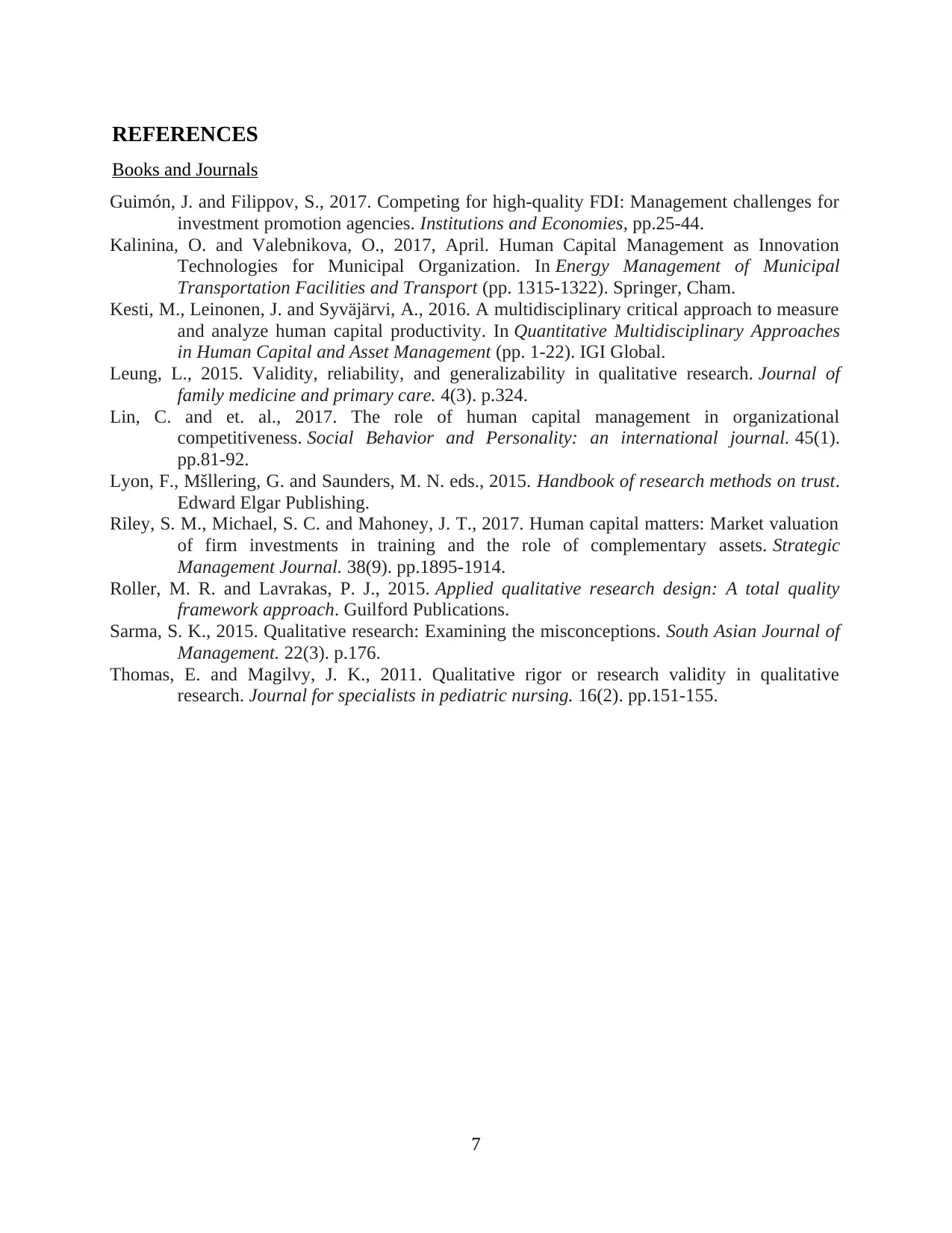
REFERENCES
Books and Journals
Guimón, J. and Filippov, S., 2017. Competing for high-quality FDI: Management challenges for
investment promotion agencies. Institutions and Economies, pp.25-44.
Kalinina, O. and Valebnikova, O., 2017, April. Human Capital Management as Innovation
Technologies for Municipal Organization. In Energy Management of Municipal
Transportation Facilities and Transport (pp. 1315-1322). Springer, Cham.
Kesti, M., Leinonen, J. and Syväjärvi, A., 2016. A multidisciplinary critical approach to measure
and analyze human capital productivity. In Quantitative Multidisciplinary Approaches
in Human Capital and Asset Management (pp. 1-22). IGI Global.
Leung, L., 2015. Validity, reliability, and generalizability in qualitative research. Journal of
family medicine and primary care. 4(3). p.324.
Lin, C. and et. al., 2017. The role of human capital management in organizational
competitiveness. Social Behavior and Personality: an international journal. 45(1).
pp.81-92.
Lyon, F., Mšllering, G. and Saunders, M. N. eds., 2015. Handbook of research methods on trust.
Edward Elgar Publishing.
Riley, S. M., Michael, S. C. and Mahoney, J. T., 2017. Human capital matters: Market valuation
of firm investments in training and the role of complementary assets. Strategic
Management Journal. 38(9). pp.1895-1914.
Roller, M. R. and Lavrakas, P. J., 2015. Applied qualitative research design: A total quality
framework approach. Guilford Publications.
Sarma, S. K., 2015. Qualitative research: Examining the misconceptions. South Asian Journal of
Management. 22(3). p.176.
Thomas, E. and Magilvy, J. K., 2011. Qualitative rigor or research validity in qualitative
research. Journal for specialists in pediatric nursing. 16(2). pp.151-155.
7
Books and Journals
Guimón, J. and Filippov, S., 2017. Competing for high-quality FDI: Management challenges for
investment promotion agencies. Institutions and Economies, pp.25-44.
Kalinina, O. and Valebnikova, O., 2017, April. Human Capital Management as Innovation
Technologies for Municipal Organization. In Energy Management of Municipal
Transportation Facilities and Transport (pp. 1315-1322). Springer, Cham.
Kesti, M., Leinonen, J. and Syväjärvi, A., 2016. A multidisciplinary critical approach to measure
and analyze human capital productivity. In Quantitative Multidisciplinary Approaches
in Human Capital and Asset Management (pp. 1-22). IGI Global.
Leung, L., 2015. Validity, reliability, and generalizability in qualitative research. Journal of
family medicine and primary care. 4(3). p.324.
Lin, C. and et. al., 2017. The role of human capital management in organizational
competitiveness. Social Behavior and Personality: an international journal. 45(1).
pp.81-92.
Lyon, F., Mšllering, G. and Saunders, M. N. eds., 2015. Handbook of research methods on trust.
Edward Elgar Publishing.
Riley, S. M., Michael, S. C. and Mahoney, J. T., 2017. Human capital matters: Market valuation
of firm investments in training and the role of complementary assets. Strategic
Management Journal. 38(9). pp.1895-1914.
Roller, M. R. and Lavrakas, P. J., 2015. Applied qualitative research design: A total quality
framework approach. Guilford Publications.
Sarma, S. K., 2015. Qualitative research: Examining the misconceptions. South Asian Journal of
Management. 22(3). p.176.
Thomas, E. and Magilvy, J. K., 2011. Qualitative rigor or research validity in qualitative
research. Journal for specialists in pediatric nursing. 16(2). pp.151-155.
7
⊘ This is a preview!⊘
Do you want full access?
Subscribe today to unlock all pages.

Trusted by 1+ million students worldwide
1 out of 9
Related Documents
Your All-in-One AI-Powered Toolkit for Academic Success.
+13062052269
info@desklib.com
Available 24*7 on WhatsApp / Email
![[object Object]](/_next/static/media/star-bottom.7253800d.svg)
Unlock your academic potential
Copyright © 2020–2025 A2Z Services. All Rights Reserved. Developed and managed by ZUCOL.





